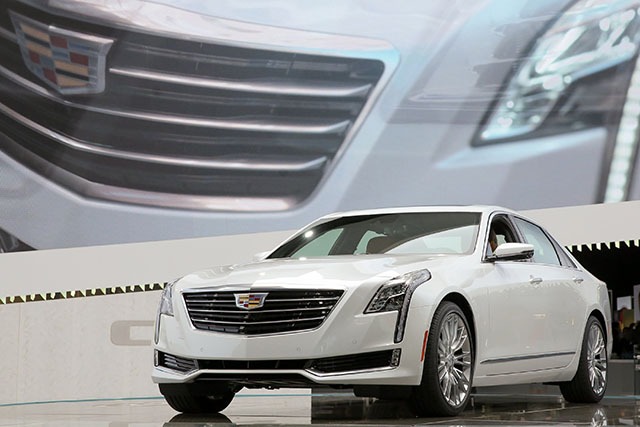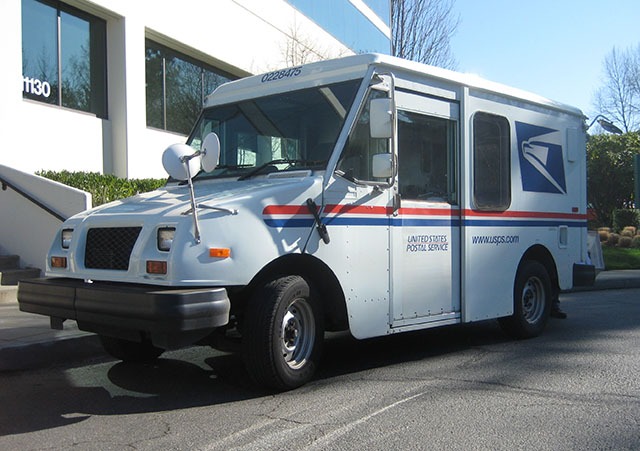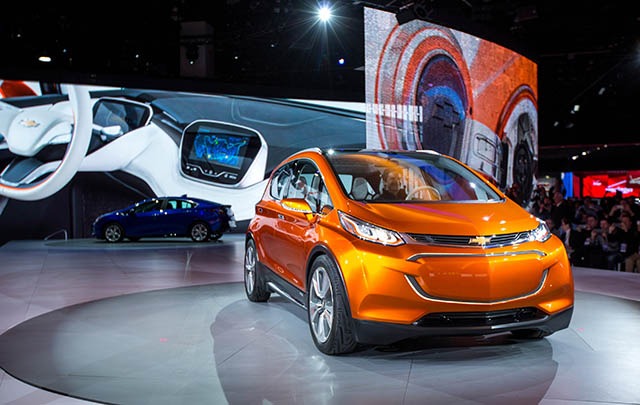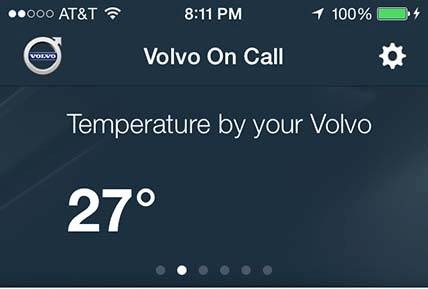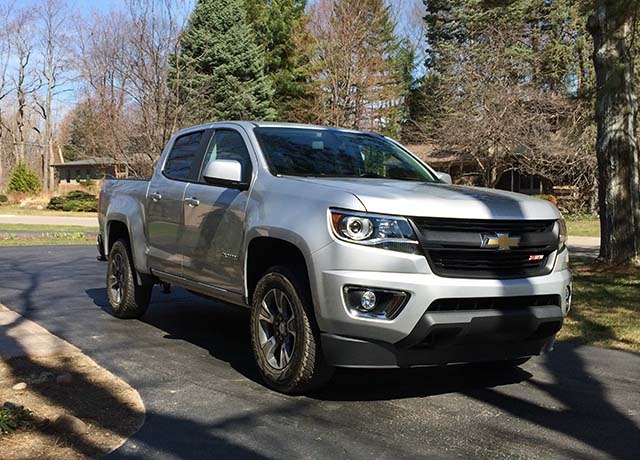-
Posts
32,884 -
Joined
-
Last visited
-
Days Won
5
Content Type
Forums
Articles
Garage
Gallery
Events
Store
Collections
Everything posted by William Maley
-
While New York was the home of the Cadillac CT6 debut, Cadillac still had something up their sleeve for Shanghai - the CT6 Plug-In Hybrid. The Plug-In Hybrid is comprised of a 2.0L turbocharged four-cylinder engine and a two electric motors. A new rear wheel electric variable transmission and 18.4 kWh battery finish off the powertrain. Total output is rated at 335 horsepower and 432 pound-feet of torque. Fuel economy numbers are expected to "more than double that of the car’s conventional engine offerings, as measured by miles per gallon equivalent." Range is unknown at this time, but Cadillac says that most buyers will be able will be able to travel using battery power for “most daily commutes.” Like the ELR, the CT6 Plug-In Hybrid will offer three different drive modes which varies the output of the powertrain. Normal: Designed for everyday commuting. Provides ideal balance of comfort, performance and maximized EV range and fuel economy. Sport: Provides more aggressive pedal mapping for improved off-the-line feel and a stiffer steering response. Hold: Allows owners to select when the CT6 PHEV uses its engine, reserving the remaining battery charge for later use. This feature helps enhance efficiency because owners who mix city and highway driving can save the battery charge for city travel, where the CT6 EV mode operates most efficiently. No word when the Plug-In version will arrive in showrooms at this time. Source: Cadillac Press Release is on Page 2 Cadillac CT6 to Offer Plug-In Hybrid Electric Technology PHEV system expected to achieve fuel economy more than double that of conventional engine Total system power estimated 335 hp and 432 lb-ft of torque Includes Regen-on-Demand system SHANGHAI - Cadillac announced today at the Shanghai Auto Show that it will add an available Plug-In Hybrid Electric (PHEV) propulsion system to its upcoming range-topping CT6 sedan. The new PHEV system is expected to more than double the fuel economy of the conventional powertrain offerings. The CT6 PHEV takes advantage of the car’s advanced lightweight structure to create a unique formula for the prestige sedan. “The first-ever CT6 is a technological showcase throughout, making it an ideal platform for Cadillac to offer its first plug-in hybrid,” said Cadillac President Johan de Nysschen. “In the CT6, Cadillac presents a new formula for prestige luxury. The advanced Plug-In Hybrid system is a key addition, providing a combination of exceptional fuel economy, crisp acceleration and strong electric-driving range.” The CT6 Plug-In Hybrid system is designed to provide all-electric driving for most daily commutes, while maximizing fuel efficiency by providing blended power from the engine and battery at higher speeds and higher loads, even when energy is stored in the battery. Battery Technology The CT6 PHEV leverages General Motors’ proven battery technology. An 18.4 kWh lithium-ion battery pack is located between the rear seat and the trunk. The battery system is comprised of 192 prismatic pouch cells, which use the latest generation cell chemistry found in other GM plug-in vehicles. With industry-leading quality levels of fewer than two problems per million battery cells produced, more than 20 million battery cells have been made for more than 73,000 GM plug-ins on the road today. The CT6 PHEV battery system will use the company’s proven active thermal control system that maintains electric range over the battery system’s life. The battery system can be charged using a 120V or 240V charger. Range estimates will be provided closer to U.S. launch of the PHEV option. Electric Variable Transmission Delivers Exceptional Performance All-electric launch performance is one of the key purchase considerations for PHEV and EV owners. The Cadillac CT6 PHEV combines an all-new rear wheel electric variable transmission (EVT) with exclusively designed motors to provide smooth, spirited acceleration. The two-motor EVT also uses three planetary gears and is mated to a 2.0L turbo 4-cylinder engine with spark-ignited direct injection and variable valve technology. The use of a two-motor system provides smooth and seamless power through the entire driving range. The combined system is capable of producing total system power of 335 hp (250 kW) and 432 lb-ft (586 Nm) of torque. “The CT6 PHEV will deliver exceptional smooth, responsive acceleration that Cadillac and luxury sedan owners demand,” said Travis Hester, Cadillac CT6 executive chief engineer. “We have managed to achieve superior drive quality when compared to our PHEV competitors due to our exclusively designed EVT.” Cadillac expects the fuel economy of the CT6 PHEV to be more than double that of the car’s conventional engine offerings, as measured by miles per gallon equivalent. Standards for measuring vehicle fuel economy differ between China and other global regions. Full details on the CT6 PHEV efficiency in the U.S. and other markets outside China will be released closer to the car’s introduction in those markets. Regenerative Braking The CT6 PHEV will feature iBooster and Electronic Stability Program tailored for hybrid electric vehicle regenerative blended braking to provide maximum energy recovery combined with reduced stopping distance and improved fuel economy over traditional regenerative braking systems. The iBooster and ESP-hev technology balance the use of the CT6 electric motors to act as generators to slow the vehicle and capture as much kinetic energy as possible during low-demand scenarios, while blending the traditional hydraulic brakes with the motors in high-demand scenarios. As expected from a driver’s car like the CT6, the system provides improved brake pedal feel and enables increased opportunity for engine stop-start operation. Operating Modes and Regen on Demand CT6 PHEV drivers will be able to select among three distinct operating modes: Normal, Sport and Hold. Normal: Designed for everyday commuting. Provides ideal balance of comfort, performance and maximized EV range and fuel economy. Sport: Provides more aggressive pedal mapping for improved off-the-line feel and a stiffer steering response. Hold: Allows owners to select when the CT6 PHEV uses its engine, reserving the remaining battery charge for later use. This feature helps enhance efficiency because owners who mix city and highway driving can save the battery charge for city travel, where the CT6 EV mode operates most efficiently. The CT6 PHEV will also feature Regen on Demand, which allows the driver to temporarily regenerate energy from vehicle momentum into electricity and store in the battery pack for later use. Regen on Demand supports a more-engaging driving experience by slowing the vehicle when entering a turn to better position it on the exit, much like downshifting with a manual transmission. Regen on Demand is engaged via steering-wheel paddles adapted from traditional performance cars.
- 5 comments
-
- Cadillac
- Cadillac CT6
- (and 5 more)
-
The U.S. Postal Service are looking for new delivery trucks to replace the current fleet - some which are around 20 years old. The Detroit News reports that there are 15 companies that range from military, mass-transit, specialized transportation, and two automakers. Those two automakers are Fiat Chrysler Automobiles and Ford. Now building a vehicle for the U.S. Postal Service isn't as easy as you might think. Here the requirements the vehicle must meet: Last at least 20 years Carry a minimum payload of 1,500 pounds Pass safety and emissions requirements Share similar design characteristics of the current vehicle “We are seeking a larger vehicle that will enable our employees to work safely and efficiently while standing inside of it. Replacing the aging light delivery fleet, much of which is 21 years or older, will also help to reduce operating and repair costs for vehicles, while simultaneously improving overall safety and efficiency of delivery operations,” said Postal Service spokeswoman Sarah Ninivaggi. Now there a lot of money on the line - the potential contact includes supplying up to 180,000 vehicles at $25,000 to $35,000 per vehicle, or about $4.5 to $6.3 billion total. Both FCA and Ford declined to comment on this. Source: The Detroit News Photo Credit: Untitled by Zena C is licensed under CC BY 2.0 View full article
-

FCA, Ford Throw Their Hats Into The Mail Truck Bidding
William Maley posted an article in Automotive Industry
The U.S. Postal Service are looking for new delivery trucks to replace the current fleet - some which are around 20 years old. The Detroit News reports that there are 15 companies that range from military, mass-transit, specialized transportation, and two automakers. Those two automakers are Fiat Chrysler Automobiles and Ford. Now building a vehicle for the U.S. Postal Service isn't as easy as you might think. Here the requirements the vehicle must meet: Last at least 20 years Carry a minimum payload of 1,500 pounds Pass safety and emissions requirements Share similar design characteristics of the current vehicle “We are seeking a larger vehicle that will enable our employees to work safely and efficiently while standing inside of it. Replacing the aging light delivery fleet, much of which is 21 years or older, will also help to reduce operating and repair costs for vehicles, while simultaneously improving overall safety and efficiency of delivery operations,” said Postal Service spokeswoman Sarah Ninivaggi. Now there a lot of money on the line - the potential contact includes supplying up to 180,000 vehicles at $25,000 to $35,000 per vehicle, or about $4.5 to $6.3 billion total. Both FCA and Ford declined to comment on this. Source: The Detroit News Photo Credit: Untitled by Zena C is licensed under CC BY 2.0- 3 comments
-
Yes
- 7 replies
-
- Connected Car
- On Call
-
(and 4 more)
Tagged with:
-
From the album: Mud's Picture Filing Cabinet
-
We know that Chevrolet will be sending the Bolt concept car into production late next year, but there a number of items still up in the air such as what will the production model will be called. Surely Chevrolet won't keep the Bolt name as it introduces confusion with the Volt, right? Tim Mahoney, Chevrolet's marketing chief tells USA Today that Bolt is sticking around. "The decision is made. The name won't be changed,"said Mahoney Mahoney explained that while the two names do sound similar, it provides Chevrolet "an advantage." That advantage is the Bolt name "association with Chevrolet is nearly immediate,"since the Volt is a well known Chevrolet. Mahoney went onto say that Chevrolet did two studies trying out the Bolt name on potential buyers. The results were the same; buyers liked the name. Source: USA Today View full article
-

Production Version of Chevrolet Bolt Will Keep the Name
William Maley posted an article in Chevrolet
We know that Chevrolet will be sending the Bolt concept car into production late next year, but there a number of items still up in the air such as what will the production model will be called. Surely Chevrolet won't keep the Bolt name as it introduces confusion with the Volt, right? Tim Mahoney, Chevrolet's marketing chief tells USA Today that Bolt is sticking around. "The decision is made. The name won't be changed,"said Mahoney Mahoney explained that while the two names do sound similar, it provides Chevrolet "an advantage." That advantage is the Bolt name "association with Chevrolet is nearly immediate,"since the Volt is a well known Chevrolet. Mahoney went onto say that Chevrolet did two studies trying out the Bolt name on potential buyers. The results were the same; buyers liked the name. Source: USA Today- 9 comments
-
That surprises me Roger since what you describe in your Canyon is basically the same in my Colorado tester. I would expect the top trim Canyon to have a six-way power seat at least.
- 24 replies
-
- 2015
- 2015 Chevrolet Colorado
- (and 6 more)
-
If I remember and I'll need to check my notes, I think that $200 also covers Volvo's Senus system which offers the same bits as Onstar.
- 7 replies
-
- Connected Car
- On Call
-
(and 4 more)
Tagged with:
-
General Motors will not have to face a number of lawsuits and as much as $10 billion in damages over a ignition-switch defect that led to the recall of 2.6 million vehicles. U.S. Bankruptcy Judge Robert Gerber announced yesterday that the bankruptcy shield, which protects new GM from claims originating before its 2009 bankruptcy and restructuring will be upheld. Now this ruling applies to a small number of suits dealing with crashes before July 2009. Most of the suits filed against GM deal with economic losses, such as diminished resale value. Judge Gerber said people claiming economic losses may “assert otherwise viable claims against New GM for any causes of action that might exist arising solely out of New GM’s own, independent, post-acts, so long as those plaintiffs’ claims do not in any way rely on any acts or conduct by Old GM.” GM was happy with Gerber's decision, saying "properly concluded" that claims based on old GM's conduct are barred. Lawyers who are representing plaintiffs against GM aren't pleased with the decision. "This ruling padlocks the courthouse doors. Hundreds of victims and their families will go to bed tonight forever deprived of justice. GM, bathing in billions, may now turn its back on the dead and injured, worry-free," said Bob Hilliard, a Texas lawyer who is representing a number of plaintiffs against GM. Source: The Detroit News View full article
- 2 replies
-
- Bankruptcy Shield
- General Motors
-
(and 2 more)
Tagged with:
-

Judge Rules General Motors Can Keep Its Bankruptcy Shield
William Maley posted an article in General Motors
General Motors will not have to face a number of lawsuits and as much as $10 billion in damages over a ignition-switch defect that led to the recall of 2.6 million vehicles. U.S. Bankruptcy Judge Robert Gerber announced yesterday that the bankruptcy shield, which protects new GM from claims originating before its 2009 bankruptcy and restructuring will be upheld. Now this ruling applies to a small number of suits dealing with crashes before July 2009. Most of the suits filed against GM deal with economic losses, such as diminished resale value. Judge Gerber said people claiming economic losses may “assert otherwise viable claims against New GM for any causes of action that might exist arising solely out of New GM’s own, independent, post-acts, so long as those plaintiffs’ claims do not in any way rely on any acts or conduct by Old GM.” GM was happy with Gerber's decision, saying "properly concluded" that claims based on old GM's conduct are barred. Lawyers who are representing plaintiffs against GM aren't pleased with the decision. "This ruling padlocks the courthouse doors. Hundreds of victims and their families will go to bed tonight forever deprived of justice. GM, bathing in billions, may now turn its back on the dead and injured, worry-free," said Bob Hilliard, a Texas lawyer who is representing a number of plaintiffs against GM. Source: The Detroit News- 2 comments
-
- Bankruptcy Shield
- General Motors
-
(and 2 more)
Tagged with:
-
With a large chunk of the population carrying some form of a smartphone, automakers are keen to take advantage of it. The past year has seen an number of smartphone applications from OEMs that provide such features as trip computer information, remote locking and starting, and locating your vehicle. The latest automaker to jump into this is Volvo with their On Call application. I had the chance to play around with this system on a 2015.5 Volvo XC60 that I was reviewing at the time. Setting up the On Call application with the XC60 proved to be an easy experience for me. Before getting the vehicle, I was sent a pin code that would pair the On Call application with XC60. Once the vehicle arrived, I followed the instructions and was able to pair my phone with the car. Now for consumers, getting On Call setup with their vehicle will be much easier as the dealer will have mostly everything setup before delivery. As for the application itself, its a very simple looking one. There are four different sections of the application which provide information about the vehicle itself: warnings on whether the vehicle has a problem, remote start and locking, and a map showing off an approximate location of the vehicle. Every time the On Call app is opened, it takes about half a minute for the application and car to connect and provide fresh data. This delay might anger some people who want immediate access, but this is more of a problem with the infrastructure to connect the phone to vehicle, not the phone or vehicle itself. This delay is also apparent when you use the remote start or locking. In my testing, I found that it took around 30 seconds for the vehicle to be locked or start when I used the app. This makes sense if you’re coming out of a mall or someplace and your car is far away to use the application. If you happen to be nearby the vehicle, it makes more sense to use the key fob. The On Call app is free for iPhone, Android, and Windows Phone devices. As for using On Call with your Volvo, the first six months are free. After that, a 12 month subscription costs around $200.00. So does it make sense to go for the On Call application with your Volvo? At the moment I have to say no. It's not to say the technology or the benefit is there. I think its more of a solution to a problem that hasn’t been found at the moment. It also adds more complexity to something that is as simple as operating a key fob. The On Call app is a great party trick you can show off, but I don’t know if it is much more than that. Disclaimer: Volvo Provided the XC60 and Access to the On Call Application View full article
- 7 replies
-
- Connected Car
- On Call
-
(and 4 more)
Tagged with:
-
With a large chunk of the population carrying some form of a smartphone, automakers are keen to take advantage of it. The past year has seen an number of smartphone applications from OEMs that provide such features as trip computer information, remote locking and starting, and locating your vehicle. The latest automaker to jump into this is Volvo with their On Call application. I had the chance to play around with this system on a 2015.5 Volvo XC60 that I was reviewing at the time. Setting up the On Call application with the XC60 proved to be an easy experience for me. Before getting the vehicle, I was sent a pin code that would pair the On Call application with XC60. Once the vehicle arrived, I followed the instructions and was able to pair my phone with the car. Now for consumers, getting On Call setup with their vehicle will be much easier as the dealer will have mostly everything setup before delivery. As for the application itself, its a very simple looking one. There are four different sections of the application which provide information about the vehicle itself: warnings on whether the vehicle has a problem, remote start and locking, and a map showing off an approximate location of the vehicle. Every time the On Call app is opened, it takes about half a minute for the application and car to connect and provide fresh data. This delay might anger some people who want immediate access, but this is more of a problem with the infrastructure to connect the phone to vehicle, not the phone or vehicle itself. This delay is also apparent when you use the remote start or locking. In my testing, I found that it took around 30 seconds for the vehicle to be locked or start when I used the app. This makes sense if you’re coming out of a mall or someplace and your car is far away to use the application. If you happen to be nearby the vehicle, it makes more sense to use the key fob. The On Call app is free for iPhone, Android, and Windows Phone devices. As for using On Call with your Volvo, the first six months are free. After that, a 12 month subscription costs around $200.00. So does it make sense to go for the On Call application with your Volvo? At the moment I have to say no. It's not to say the technology or the benefit is there. I think its more of a solution to a problem that hasn’t been found at the moment. It also adds more complexity to something that is as simple as operating a key fob. The On Call app is a great party trick you can show off, but I don’t know if it is much more than that. Disclaimer: Volvo Provided the XC60 and Access to the On Call Application
- 7 comments
-
- Connected Car
- On Call
-
(and 4 more)
Tagged with:
-
From the album: Volvo On Call - iPhone
-
From the album: Volvo On Call - iPhone
-
From the album: Volvo On Call - iPhone
-
From the album: Volvo On Call - iPhone
-
From the album: Volvo On Call - iPhone
-
From the album: Volvo On Call - iPhone
-
I'm slightly doubting that since I had trouble getting in the back with the passenger set slightly back. I'll try it tomorrow. Don't believe so at this time.
- 24 replies
-
- 2015
- 2015 Chevrolet Colorado
- (and 6 more)
-
Another week is upon us and a new review vehicle has arrived. In this case it happens to be the 2015 Chevrolet Colorado Z71. This is one of the vehicles that I have been waiting for quite awhile to get my hands on for review and its finally here. My particular tester is a Z71 crew cab with Short bed. With a couple of options ticked off, it rings in at $36,710. First impressions are quite good. The Colorado is quite the sharp looker with silver paint and 17-inch wheels. Moving inside and the controls are within easy reach and the seats are wrapped in a leather/cloth combination. Chevrolet MyLink so far hasn't crashed or showed any sign of slowdown. Also, this is one of the first GM vehicles with OnStar 4G LTE and wi-fi connectivity. I'll have more on this later in the week. There are a couple of downsides that I have found/experienced at the moment. One is there appears not to be enough adjustments in the seat and steering wheel to make myself comfortable at the moment. Currently, my knees are touching the steering wheel column. The other is a somewhat slow transmission. When I was driving on the freeway and trying to make a pass, the transmission took a few seconds to upshift. I'll have some more thoughts and impressions as the week goes on. In the meantime, if you have questions you would like to answer, drop them below. View full article
- 24 replies
-
- 2015
- 2015 Chevrolet Colorado
- (and 6 more)
-
Another week is upon us and a new review vehicle has arrived. In this case it happens to be the 2015 Chevrolet Colorado Z71. This is one of the vehicles that I have been waiting for quite awhile to get my hands on for review and its finally here. My particular tester is a Z71 crew cab with Short bed. With a couple of options ticked off, it rings in at $36,710. First impressions are quite good. The Colorado is quite the sharp looker with silver paint and 17-inch wheels. Moving inside and the controls are within easy reach and the seats are wrapped in a leather/cloth combination. Chevrolet MyLink so far hasn't crashed or showed any sign of slowdown. Also, this is one of the first GM vehicles with OnStar 4G LTE and wi-fi connectivity. I'll have more on this later in the week. There are a couple of downsides that I have found/experienced at the moment. One is there appears not to be enough adjustments in the seat and steering wheel to make myself comfortable at the moment. Currently, my knees are touching the steering wheel column. The other is a somewhat slow transmission. When I was driving on the freeway and trying to make a pass, the transmission took a few seconds to upshift. I'll have some more thoughts and impressions as the week goes on. In the meantime, if you have questions you would like to answer, drop them below.
- 24 comments
-
- 2015
- 2015 Chevrolet Colorado
- (and 6 more)
-
The fate of the Cadillac ELR has been up in the air with no real updates to the model since it was introduced in the 2014 model year, and Cadillac's boss saying there will likely not be a second-generation model. But at least for the time being, Cadillac has introduced some new changes for the 2016 model. No real big changes on the ELR's exterior, only a tweaked grille and wreath-less crest. But the powertrain has seen some big changes. New software upgrades boost power output from 207 horsepower and 295 pound-feet of torque to 233 horsepower and 373 pound-feet. The increase in power drops 0-60 MPH time by 1.5 seconds to 6.4 seconds and top speed is increased to 130 MPH when equipped with the Performance Package and 106 MPH on the standard model. All ELR models get a number of changes to the suspension which include a new calibration of the HiPer strut front suspension, stiffer rear axle, and new settings for the Continuous Damping Control system. New for the 2016 ELR is the addition of a optional Performance Package which adds: New 20-inch summer-only performance tires – mounted on new sport wheels – that improve lateral grip by nearly 10 percent Front Brembo four-piston brake calipers (with the Cadillac script), with 13.6-inch-diameter vented front rotors and 12.4-inch vented rear rotors that improve 60-to-0 mph stopping distance by nearly 12 percent Specific calibrations for the Continuous Damping Control and electric power steering systems Sport steering wheel with a thicker rim for a sportier feel. As for tech, the 2016 ELR boasts OnStar with 4G LTE and standard built-in WiFi, an inductive charge spot on the instrument panel to charge your phone, and the previously optional Driver Assistance package which featured blind spot monitoring and rear cross traffic alert as standard. Cadillac says the ELR will go on sale with a price of $58,495 after federal tax credits for electric cars are taken into account. Source: Cadillac Press Release is on Page 2 2016 ELR Advances with More Power, Technology Revised electric drive system increases power and torque by more than 25 percent Enhanced handling, steering and braking OnStar with 4G LTE and standard built-in Wi-Fi hotspot DETROIT – Cadillac today announced the ELR electrified luxury coupe will offer a host of upgrades for the 2016 model year, including boosts in acceleration, driving performance and connectivity. Major product upgrades include a more than 25 percent boost in power and torque, faster acceleration that improves 0-60 mph by 1.5 seconds, higher top speed, retuned chassis and steering for better handling, more responsive brakes and a new Performance equipment package. “ELR’s combination of leading technology with stunningly attractive design is unlike any other coupe in the luxury segment,” said Cadillac President Johan de Nysschen. "The upgraded ELR offers enhanced driving performance for buyers seeking uncompromising luxury and exquisite craftsmanship with electrification technology. It is unique in the luxury category, in that it completely eliminates conventional concerns over driving range, which has been the Achilles’ heel of other competitors in the luxury segment.” Distinguished by a new grille and Cadillac’s new crest, the 2016 ELR, which features the first application of extended-range electric vehicle technology by a full-line luxury automotive brand, will start at $58,495 net pricing after U.S. federal tax credits. The 2016 ELR’s steering and suspension upgrades include: Revised calibration of the HiPer Strut front suspension Increased front spring rates and a stiffer rear axle Stiffer bushings for the front lower control arms, cradle mounts and Watts link in the rear suspension, for more precise control with no loss of ride quality Revised calibrations for the Continuous Damping Control system Front Damper Rebound Spring added New steering calibration tuned to complement the revised chassis and suspension systems Revised brake hardware and system calibration for improved application feel. A new optional Performance Package elevates the ELR’s driving experience further with greater handling and braking capability – and a more direct, linear feel for the driver. The ELR Performance Package includes: New 20-inch summer-only performance tires – mounted on new sport wheels – that improve lateral grip by nearly 10 percent Front Brembo four-piston brake calipers (with the Cadillac script), with 13.6-inch-diameter vented front rotors and 12.4-inch vented rear rotors that improve 60-to-0 mph stopping distance by nearly 12 percent Specific calibrations for the Continuous Damping Control and electric power steering systems Sport steering wheel with a thicker rim for a sportier feel. ELR propulsion and drive technology All 2016 ELRs contain software upgrades to the battery system improving power and acceleration, with EV range growing on the base model. Additionally, the 2016 ELR has a modified Sport mode that enables the propulsion system to combine engine and electric motor power to take the ELR from 0-60 in 6.4 seconds, a 1.5 second improvement from the current model. ELR continues to offer Regen on Demand, recipient of Green Car Journal’s 2014 Green Car Technology Award. Slightly enhanced for the 2016 model to improve deceleration, Regen on Demand allows the driver to temporarily regenerate energy from the ELR’s momentum into electricity and store in the battery pack for later use. Regen on Demand supports a more engaging driving experience by slowing the vehicle when entering a turn to better position it on the exit, much like downshifting with a manual transmission. Regen on Demand is engaged via steering-wheel paddles adapted from traditional performance cars. The ELR offers a full driving range of up to 330 miles (530 km), combining pure electric driving and an efficient, range-extending 1.4L gasoline-powered engine-generator. It’s a combination that means most daily commutes will require zero gasoline with zero tailpipe emissions. Longer trips are free from electric-vehicle range anxiety because the ELR’s technology enables the long-distance travel similar to vehicles powered only by gasoline. The T-shaped battery pack is located along the centerline of the vehicle, between the front and rear wheels for optimal weight distribution. The 5.5-foot-long (1.6 m), 435-pound (198 kg) pack supplies energy to an advanced electric drive unit capable of 373 lb-ft of instant torque (506 Nm) to propel the vehicle. Using only the energy stored in the battery, the ELR will deliver an estimated range of about 39 miles (60 km) of pure electric driving, depending on terrain, driving techniques and temperature. The optional Performance Package reduces EV range by about four miles as a result of the enhanced grip of the 20-inch summer-only tires. ELR’s battery can be charged using either a 120- or 240-volt charger. The vehicle can be completely recharged in about five hours using 240V charging, depending on the outside temperature. The ELR’s battery is covered by an eight-year/100,000-mile warranty or 10 years/150,000 miles in states following Air Resource Board guidelines. Personal technology The 2016 ELR will be one of the industry’s most-connected vehicles, with new and enhanced features designed to extend technologies woven into nearly every facet of customers’ lives. OnStar with 4G LTE and standard built-in Wi-Fi hotspot provides a mobile hub for drivers and passengers to stay connected. The hotspot is on whenever the vehicle is on and comes with a three-month/three-gigabyte data trial, whichever comes first. 4G LTE is the most current and fastest mobile data network and the Wi-Fi hotspot supports up to seven connected devices. ELR drivers and passengers can also recharge their enabled phones wirelessly with a new magnetic inductive charge spot on the instrument panel. There is no need to plug the phone in for charging, leaving the ELR’s USB ports free for other devices. Interior luxury and technology For 2016, the Driver Assistance active safety systems, optional on the current ELR, are standard and include side blind zone alert, rear cross traffic alert and Intellibeam headlamps. Lane change alert and a new vehicle security system are also standard. Adaptive cruise control is available. Additional interior features include: Cut-and-sew interior Available Semi-Aniline full leather seating Sueded microfiber headliner and supporting trim Eight-inch configurable instrument and driver information displays, offering four configurations ranging from elegantly simple to technologically detailed information Three USB ports Power-assist covered storage/cup holder in the center console Fold-down rear seatbacks to accommodate longer items such as skis and golf clubs View full article



